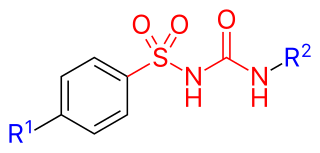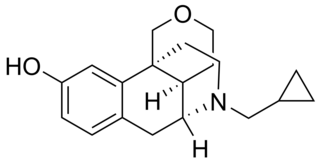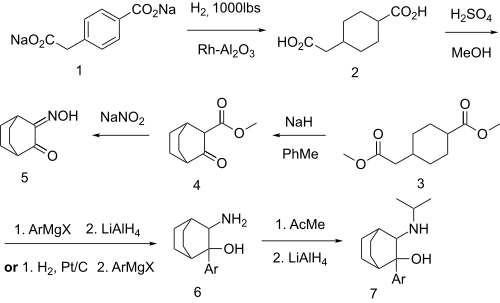
Acetophenone is the organic compound with the formula C6H5C(O)CH3. It is the simplest aromatic ketone. This colorless, viscous liquid is a precursor to useful resins and fragrances.

Sulfonylureas are a class of organic compounds used in medicine and agriculture, for example as antidiabetic drugs widely used in the management of diabetes mellitus type 2. They act by increasing insulin release from the beta cells in the pancreas. A number of sulfonylureas are also used as herbicides, because they can interfere with plant biosynthesis of certain amino acids. Sulfonylureas are also used experimentally to inhibit interleukin 1 beta release from the NALP3 inflammasome.

Rimantadine is an orally administered antiviral drug used to treat, and in rare cases prevent, influenzavirus A infection. When taken within one to two days of developing symptoms, rimantadine can shorten the duration and moderate the severity of influenza. Rimantadine can mitigate symptoms, including fever. Both rimantadine and the similar drug amantadine are derivates of adamantane. Rimantadine is found to be more effective than amantadine because when used the patient displays fewer symptoms. Rimantadine was approved by the Food and Drug Administration (FDA) in 1994.

Nomifensine is a norepinephrine-dopamine reuptake inhibitor, i.e. a drug that increases the amount of synaptic norepinephrine and dopamine available to receptors by blocking the dopamine and norepinephrine reuptake transporters. This is a mechanism of action shared by some recreational drugs like cocaine and the medication tametraline. Research showed that the (S)-isomer is responsible for activity.

Anthranilic acid is an aromatic acid with the formula C6H4(NH2)(CO2H) and has a sweetish taste. The molecule consists of a benzene ring, ortho-substituted with a carboxylic acid and an amine. As a result of containing both acidic and basic functional groups, the compound is amphoteric. Anthranilic acid is a white solid when pure, although commercial samples may appear yellow. The anion [C6H4(NH2)(CO2)]−, obtained by the deprotonation of anthranilic acid, is called anthranilate. Anthranilic acid was once thought to be a vitamin and was referred to as vitamin L1 in that context, but it is now known to be non-essential in human nutrition.

Clobenzorex is a stimulant drug of the amphetamine chemical class used as an appetite suppressant. The drug is legally distributed in Mexico under the trade name Asenlix by Aventis.

Zomepirac is an orally effective nonsteroidal anti-inflammatory drug (NSAID) that has antipyretic actions. It was developed by McNeil Pharmaceutical, approved by the FDA in 1980, and sold as the sodium salt zomepirac sodium, under the brand name Zomax. Due to its clinical effectiveness, it was preferred by doctors in many situations and obtained a large share of the analgesics market; however, it was subsequently withdrawn in March 1983 due to its tendency to cause serious anaphylaxis in a small, but unpredictable, subset of the patient population.

Metitepine, also known as methiothepin, is a drug described as a "psychotropic agent" of the tricyclic group which was never marketed. It acts as a non-selective antagonist of serotonin, dopamine, and adrenergic receptors and has antipsychotic properties.

Girisopam is a drug which is a 2,3-benzodiazepine derivative, related to tofisopam and zometapine. It has selective anxiolytic action with no sedative, anticonvulsant or muscle relaxant effects.

Diclofensine was developed by Hoffmann-La Roche in the 1970s in the search for a new antidepressant. It was found that the (S)-isomer was responsible for activity. Is a stimulant drug which acts as a triple monoamine reuptake inhibitor, primarily inhibiting the reuptake of dopamine and norepinephrine, with affinities (Ki) of 16.8 nM, 15.7 nM, and 51 nM for DAT, NET, and SERT, respectively. It was found to be an effective antidepressant in human trials, with relatively few side effects, but was ultimately dropped from clinical development, possibly due to concerns about its abuse potential.

Osanetant (developmental code name SR-142,801) is a neurokinin 3 receptor antagonist which was developed by Sanofi-Synthélabo and was being researched for the treatment of schizophrenia but was discontinued. It was the first non-peptide NK3 antagonist developed in the mid-1990s. Another potential application for osanetant is in the treatment of drug addiction, as it has been found to block the effects of cocaine in animal models. Also, Professor David J. Anderson, Director and Leadership Chair of the Tianqiao and Chrissy Chen Institute for Neuroscience at California Institute of Technology, has advocated that osanetant be explored as a treatment for pain, anxiety, and aggression in humans and companion animals experiencing bereavement or social isolation, citing research suggesting that osanetant has an excellent safety profile and suppresses negative effects of social isolation in mice through an evolutionarily-conserved mechanism and without acting as a depressant.

Drostanolone, or dromostanolone, is an anabolic–androgenic steroid (AAS) of the dihydrotestosterone (DHT) group which was never marketed. An androgen ester prodrug of drostanolone, drostanolone propionate, was formerly used in the treatment of breast cancer in women under brand names such as Drolban, Masteril, and Masteron. This has also been used non-medically for physique- or performance-enhancing purposes.

Semustine is an alkylating nitrosourea compound used in chemotherapy treatment of various types of tumours. Due to its lipophilic property, semustine can cross the blood-brain barrier for the chemotherapy of brain tumours, where it interferes with the cellular DNA of the highly dividing cells. Semustine, just as lomustine, is administered orally. It has been reported that semustine can perform the main mechanism of action at molecular level via the alkylation of DNA nitrogenous bases in duplex by results of inhibition of DNA replication, transcription, and translation by way of alkylation of DNA, under pH-dependent conditions by hydrolysis, forming chloro-carbonium ions. Sufficient evidence was found that treatment with semustine can cause acute leukaemia as a delayed effect in very rare cases.

Medrogestone, sold under the brand name Colprone among others, is a progestin medication which has been used in menopausal hormone therapy and in the treatment of gynecological disorders. It is available both alone and in combination with an estrogen. It is taken by mouth.

Igmesine (JO-1,784) is a sigma receptor agonist (IC50 = 39 nM (rat brain)). It has neuroprotective and antidepressant-like effects in animal studies, as well as nootropic effects in models of age-related cognitive decline. In two phase II clinical trials, igmesine was found to be effective in the treatment of depression and was as active as the comparator fluoxetine. However, in a large phase III clinical trial, igmesine failed to show significant effectiveness for depression. The drug has not been developed further.

Alvameline (Lu 25-109) is a M1 receptor agonist and M2/M3 receptor antagonist that was under investigation for the treatment of Alzheimer's disease, but produced poor results in clinical trials and was subsequently discontinued.

Tazomeline (LY-287,041) is a drug which acts as a non-selective muscarinic acetylcholine receptor agonist. It was in clinical trials for the treatment of cognitive dysfunction such as that seen in Alzheimer's disease and schizophrenia, but development was apparently scrapped for unknown reasons. Another of the patented uses is for the treatment of "severe painful conditions".

Proxorphan (INN), also known as proxorphan tartate (USAN), is an opioid analgesic and antitussive drug of the morphinan family that was never marketed. It acts preferentially as a κ-opioid receptor partial agonist and to a lesser extent as a μ-opioid receptor partial agonist.

3,4-Dichloroamphetamine (DCA), is an amphetamine derived drug invented by Eli Lilly in the 1960s, which has a number of pharmacological actions. It acts as a highly potent and selective serotonin releasing agent (SSRA) and binds to the serotonin transporter with high affinity, but also acts as a selective serotonergic neurotoxin in a similar manner to the related para-chloroamphetamine, though with slightly lower potency. It is also a monoamine oxidase inhibitor (MAOI), as well as a very potent inhibitor of the enzyme phenylethanolamine N-methyl transferase which normally functions to transform noradrenaline into adrenaline in the body.

Sodium nitroprusside (SNP), sold under the brand name Nitropress among others, is a medication used to lower blood pressure. This may be done if the blood pressure is very high and resulting in symptoms, in certain types of heart failure, and during surgery to decrease bleeding. It is used by continuous injection into a vein. Onset is nearly immediate and effects last for up to ten minutes. It has been known to cause reflex tachycardia. It is often used as the vasodilator of choice in acute, emergency situations.





















